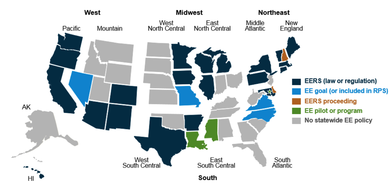
There has also been some wishful thinking that the new administration’s infrastructure and jobs agenda could include energy efficiency work. I hate to break it to everyone, but when Trump says infrastructure and energy, he means coal and fracking, not cash-for-caulkers.
But while we can expect a stiff headwind from Washington DC for the next few years, the good news for energy efficiency is that the federal government has never had a lot of energy efficiency public policy levers at its disposal. Our earlier failure to get meaningful national policy in place for EE (e.g. HomeStar, Homes Act, Save Act, etc.), now means the industry is, thankfully, not addicted to the federal juice.
The real action in energy efficiency is, and always has been, at with state policy makers, utilities and in the hundreds of Public Utility Commissions that make up the energy regulatory landscape.
So the silver lining for energy efficiency during this next administration is that what was in the past a systemwide bug that made it hard to bring helpful federal EE policies to the states, is now a feature that can insulate the industry from the climate-unfriendly policies of a new administration.
The good news for efficiency specifically is that it's really hard for federal officials to affect policy at the state level. This fundamental principle of American government and federalism will not change for the next administration. State-based energy efficiency innovation can and will continue to flourish despite the onslaught of revanchist policies from the federal government.

 RSS Feed
RSS Feed